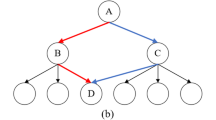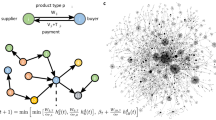Abstract
Social and economic networks can be a channel of negative shocks and thus deteriorate resilience and sustainability in societies. This study focuses on supply chains, or supplier–customer networks of firms and examines how these supply chains enable production losses caused by natural disasters to propagate and persist in regions not directly affected by the disaster. We apply an agent-based model to the actual supply chains of nearly one million firms in Japan to estimate the direct and indirect effects of the 2011 Great East Japan earthquake. We then employ the same model to predict the effect of the Nankai Trough earthquake, a mega earthquake predicted to hit major industrial cities in Japan in the near future. We find that the indirect effects of the disasters on production due to propagation (10.6% of gross domestic product in the case of the Nankai earthquake) are substantially larger than their direct effects (0.5%). Our simulation analyses to compare the actual network with hypothetical networks suggest that these indirect effects are more prominent and persistent when supply chains are characterized by scale-free properties, difficulty in substitution among intermediate products, and complex cycles in networks.
This is a preview of subscription content, access via your institution
Access options
Access Nature and 54 other Nature Portfolio journals
Get Nature+, our best-value online-access subscription
$29.99 / 30 days
cancel any time
Subscribe to this journal
Receive 12 digital issues and online access to articles
$119.00 per year
only $9.92 per issue
Buy this article
- Purchase on Springer Link
- Instant access to full article PDF
Prices may be subject to local taxes which are calculated during checkout





Similar content being viewed by others
Data availability
The data that support the findings of this study are licensed from TSR to RIETI where the authors conducted this study and are available from TSR for a fee (http://www.tsr-net.co.jp/). Because of the restriction in the licensing agreement between TSR and RIETI, the authors have no right to disclose the data publicly.
Code availability
The simulation code can be accessed at https://github.com/HiroyasuInoue/ProductionNetworkSimulator. The minimal input for the code is supplier–client relationships, firms’ initial productions and supplies to final consumers, and industrial sectors of firms. The test data for the minimal inputs are also provided.
References
Barabási, A.-L. Network Science (Cambridge Univ. Press, 2016).
Watts, D. & Strogatz, S. Collective dynamics of ‘small-world’ networks. Nature 393, 440–442 (1998).
Watts, D. Small Worlds: The Dynamics of Networks Between Order and Randomness (Princeton Univ. Press, 1999).
Valente, T. W. Network Models of the Diffusion of Innovations (Hampton Press, 1995).
Banerjee, A., Chandrasekhar, A. G., Duflo, E. & Jackson, M. O. The diffusion of microfinance. Science 341, 1236498 (2013).
Kreindler, G. E. & Young, H. P. Rapid innovation diffusion in social networks. Proc. Natl Acad. Sci. USA 111, 10881–10888 (2014).
Acemoglu, D., Akcigit, U. & Kerr, W. R. Innovation network. Proc. Natl Acad. Sci. USA 113, 11483–11488 (2016).
Jackson, M. O. Social and Economic Networks (Princeton Univ. Press, 2010).
Battiston, S., Puliga, M., Kaushik, R., Tasca, P. & Caldarelli, G. Debtrank: too central to fail? Financial networks, the fed and systemic risk. Sci. Rep. 2, 541 (2012).
Thurner, S. & Poledna, S. Debtrank-transparency: controlling systemic risk in financial networks. Sci. Rep. 3, 1888 (2013).
Huang, X., Vodenska, I., Havlin, S. & Stanley, H. E. Cascading failures in bi-partite graphs: model for systemic risk propagation. Sci. Rep. 3, 1219 (2013).
Carvalho, V., Nirei, M., Saito, Y. & Tahbaz-Salehi, A. Supply Chain Disruptions: Evidence from The Great East Japan Earthquake Research Paper 17-5 (Columbia Business School, 2016).
Barrot, J. & Sauvagnat, J. Input specificity and the propagation of idiosyncratic shocks in production networks. Q. J. Econ. 131, 1543–1592 (2016).
Tierney, K. Business impacts of the northridge earthquake. J. Conting. Crisis Man. 5, 87–97 (1997).
Pelling, M., Özerdem, A. & Barakat, S. The macro-economic impact of disasters. Prog. Dev. Stud. 2, 283–305 (2002).
Acemoglu, D., Carvalho, V., Ozdaglar, A. & Alireza, T. The network origins of aggregate fluctuations. Econometrica 80, 1977–2016 (2012).
Acemoglu, D., Akcigit, U. & Kerr, W. Networks and the macroeconomy: an empirical exploration. NBER Macroecon. Annu. 30, 273–335 (2016).
Bak, P., Chen, K., Scheinkman, J. & Woodford, M. Aggregate fluctuations from independent sectoral shocks: self-organized criticality in a model of production and inventory dynamics. Ric. Econ. 47, 3–30 (1993).
Delli Gatti, D. et al. A new approach to business fluctuations: heterogeneous interacting agents, scaling laws and financial fragility. J. Econ. Behav. Organ. 56, 489–512 (2005).
Lee, K.-M. & Goh, K.-I. Strength of weak layers in cascading failures on multiplex networks: case of the international trade network. Sci. Rep. 6, 26346 (2016).
Burt, R. Structural holes and good ideas. Am. J. Sociol. 110, 349–399 (2004).
Centola, D. The spread of behavior in an online social network experiment. Science 329, 1194–1197 (2010).
Newman, M. Networks: An Introduction (Oxford Univ. Press, 2010).
Watts, D. J. A simple model of global cascades on random networks. Proc. Natl Acad. Sci. USA 99, 5766–5771 (2002).
Fujiwara, Y. & Aoyama, H. Large-scale structure of a nation-wide production network. Eur. Phys. J. B 77, 565–580 (2010).
Saito, Y. U., Watanabe, T. & Iwamura, M. Do larger firms have more interfirm relationships? Physica A 383, 158–163 (2007).
Haimes, Y. & Jiang, P. Leontief-based model of risk in complex interconnected infrastructures. J. Infrastruct. Syst. 7, 1–12 (2001).
Santos, J. & Haimes, Y. Modeling the demand reduction input-output (i-o) inoperability due to terrorism of interconnected infrastructures. Risk Anal. 24, 1437–1451 (2004).
Okuyama, Y., Hewings, G. J. & Sonis, M. in Modeling Spatial and Economic Impacts of Disasters (eds Okuyama, Y. & Chang, S. E.) 77–101 (Springer, 2004).
Rose, A. & Liao, S. Modeling regional economic resilience to disasters: a computable general equilibrium analysis of water service disruptions. J. Reg. Sci. 45, 75–112 (2005).
Hallegatte, S. An adaptive regional input-output model and its application to the assessment of the economic cost of Katrina. Risk Anal. 28, 779–799 (2008).
Hallegatte, S. Modeling the Roles of Heterogeneity, Substitution, and Inventories in the Assessment of Natural Disaster Economic Costs (The World Bank, 2012).
Henriet, F., Hallegatte, S. & Tabourier, L. Firm-network characteristics and economic robustness to natural disasters. J. Econ. Dyn. Control 36, 150–167 (2012).
Inoue, H. & Todo, Y. Propagation of negative shocks through firm networks: evidence from simulation on comprehensive supply-chain data. PLoS ONE 14, e0213648 (2019).
Beroza, G. C. How many great earthquakes should we expect? Proc. Natl Acad. Sci. USA 109, 651–652 (2012).
Milly, P. C. D., Wetherald, R. T., Dunne, K. & Delworth, T. L. Increasing risk of great floods in a changing climate. Nature 415, 514–517 (2002).
Fujimoto, T. Supply Chain Competitiveness and Robustness: A Lesson from the 2011 Tohoku Earthquake and Supply Chain ‘Virtual Dualization’ (Manufacturing Management Research Center, 2011).
Cohen, R., Havlin, S. & Ben-Avraham, D. in Handbook of Graphs and Networks: From the Genome to the Internet (eds Bornholdt, S. & Schuster, H. G.) 85–110 (Wiley‐VCH, 2003).
Valente, T. W. Social Networks and Health: Models, Methods, and Applications (Oxford Univ. Press, 2010).
Valente, T. W. Putting the network in network interventions. Proc. Natl Acad. Sci. USA 114, 9500–9501 (2017).
Aoki, M. Information, Incentives and Bargaining in the Japanese Economy: A Microtheory of the Japanese Economy (Cambridge Univ. Press, 1988).
Alshamsi, A., Pinheiro, F. L. & Hidalgo, C. A. Optimal diversification strategies in the networks of related products and of related research areas. Nat. Commun. 9, 1328 (2018).
The 2011 Updated Input–output Table (METI, 2011).
Broder, A. et al. Graph structure in the web. Comput. Netw. 33, 309–320 (2000).
White Paper on Disaster Management (Cabinet Office in Japan, 2012).
White Paper on International Economy and Trade (METI, 2011).
White Paper on Disaster Management (Cabinet Office in Japan, 2014).
Acknowledgements
This research was conducted as part of a project entitled ‘Large-scale Simulation and Analysis of Economic Network for Macro Prudential Policy,’ undertaken at the Research Institute of Economy, Trade, and Industry. This research was also supported by MEXT as Exploratory Challenges on Post-K computer (Studies of Multi-level Spatiotemporal Simulation of Socioeconomic Phenomena). The authors thank H. Aoyama, N. Ito, Y. Fujiwara, other members of Exploratory Challenges on Post-K computer, S. Hallegatte, M. Yano and seminar participants at RIETI and the World Bank for helpful comments. The authors are also grateful for the financial support of JSPS Kakenhi Grant Nos. 15K01217, 18K04615, 18H03642 and 25101003. The opinions expressed and arguments employed herein do not necessarily reflect those of RIETI, University of Hyogo, Waseda University, or any institution with which the authors are affiliated.
Author information
Authors and Affiliations
Contributions
H.I. and Y.T. designed the research. H.I. performed the research and analysed the data. H.I. and Y.T. wrote the paper.
Corresponding author
Ethics declarations
Competing interests
The authors declare no competing interests.
Additional information
Publisher’s note: Springer Nature remains neutral with regard to jurisdictional claims in published maps and institutional affiliations.
Additional information
Supplementary Information
Supplementary methods, Supplementary Figs. 1–6, Supplementary Videos 1 and 2, Supplementary refs. 1–14.
Supplementary Video 1
The video shows the simulated geographic propagation of negative shocks directly caused by the 2011 Japan earthquake through supply chains for 100 days after the earthquake.
Supplementary Video 2
The video shows the simulated geographic propagation of negative shocks directly caused by the Nankai earthquake through supply chains for 100 days after the earthquake.
Rights and permissions
About this article
Cite this article
Inoue, H., Todo, Y. Firm-level propagation of shocks through supply-chain networks. Nat Sustain 2, 841–847 (2019). https://doi.org/10.1038/s41893-019-0351-x
Received:
Accepted:
Published:
Issue Date:
DOI: https://doi.org/10.1038/s41893-019-0351-x
This article is cited by
-
Commodity-specific triads in the Dutch inter-industry production network
Scientific Reports (2024)
-
Global supply chains amplify economic costs of future extreme heat risk
Nature (2024)
-
Shaking up Foreign Finance: FDI in a Post-Disaster World
Economics of Disasters and Climate Change (2024)
-
Networks in Japanese regional agro-food economies: an empirical exploration of the network linkage model
Journal of Economic Structures (2023)
-
Supply chains create global benefits from improved vaccine accessibility
Nature Communications (2023)



